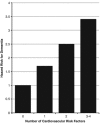Antihypertensives for combating dementia? A perspective on candidate molecular mechanisms and population-based prevention
- PMID: 22832907
- PMCID: PMC3337069
- DOI: 10.1038/tp.2012.28
Antihypertensives for combating dementia? A perspective on candidate molecular mechanisms and population-based prevention
Abstract
Age-related increases in prevalent dementia over the next 30-40 years risk collapsing medical resources or radically altering the way we treat patients. Better prevention of dementia therefore needs to be one of our highest medical priorities. We propose a perspective on the pathological basis of dementia based on a cerebrovascular-Alzheimer disease spectrum that provides a more powerful explanatory framework when considering the impact of possible public health interventions. With this in mind, a synthesis of evidence from basic, clinical and epidemiological studies indeed suggests that the enhanced treatment of hypertension could be effective for the primary prevention of dementia of either Alzheimer or vascular etiology. In particular, we focus on candidate preventative mechanisms, including reduced cerebrovascular disease, disruption of hypoxia-dependent amyloidogenesis and the potential neuroprotective properties of calcium channel blockers. Following the successful translation of large, long-term and resource-intense trials in cardiology into improved vascular health outcomes in many countries, new multinational prevention trials with dementia-related primary outcomes are now urgently required.
Figures




Similar articles
-
Treatment options and considerations for hypertensive patients to prevent dementia.Expert Opin Pharmacother. 2017 Jul;18(10):989-1000. doi: 10.1080/14656566.2017.1333599. Epub 2017 May 29. Expert Opin Pharmacother. 2017. PMID: 28532183 Review.
-
Does the treatment of isolated systolic hypertension prevent dementia?J Hum Hypertens. 1999 Jun;13(6):357-8; discussion 419-20. doi: 10.1038/sj.jhh.1000823. J Hum Hypertens. 1999. PMID: 10408583 Review. No abstract available.
-
Calcium channel blockers and stroke.Aging Clin Exp Res. 2005 Aug;17(4 Suppl):16-30. Aging Clin Exp Res. 2005. PMID: 16640170 Review.
-
Progress in cardiovascular diseases: cognitive function in essential hypertension.Prog Cardiovasc Dis. 2006 Jul-Aug;49(1):1-10. doi: 10.1016/j.pcad.2006.03.001. Prog Cardiovasc Dis. 2006. PMID: 16867845 Review.
-
Hypertension & dementia: Pathophysiology & potential utility of antihypertensives in reducing disease burden.Pharmacol Ther. 2024 Jan;253:108575. doi: 10.1016/j.pharmthera.2023.108575. Epub 2023 Dec 3. Pharmacol Ther. 2024. PMID: 38052309 Review.
Cited by
-
If Human Brain Organoids Are the Answer to Understanding Dementia, What Are the Questions?Neuroscientist. 2020 Oct-Dec;26(5-6):438-454. doi: 10.1177/1073858420912404. Epub 2020 Apr 13. Neuroscientist. 2020. PMID: 32281909 Free PMC article. Review.
-
Cognitive Associates of Current and More Intensive Control of Hypertension: Findings From the Hispanic Community Health Study/Study of Latinos.Am J Hypertens. 2017 Jun 1;30(6):624-631. doi: 10.1093/ajh/hpx023. Am J Hypertens. 2017. PMID: 28402388 Free PMC article.
-
Chronic arterial hypertension impedes glioma growth: a multiparametric MRI study in the rat.Hypertens Res. 2015 Nov;38(11):723-32. doi: 10.1038/hr.2015.66. Epub 2015 Jun 18. Hypertens Res. 2015. PMID: 26084262
-
Perspectives for treating Alzheimer's disease: a review on promising pharmacological substances.Sao Paulo Med J. 2016 Jul-Aug;134(4):342-54. doi: 10.1590/1516-3180.2015.01980112. Sao Paulo Med J. 2016. PMID: 27557144 Free PMC article. Review.
-
Cerebral white matter hyperintensities in the prediction of cognitive decline and incident dementia.Int Rev Psychiatry. 2013 Dec;25(6):686-98. doi: 10.3109/09540261.2013.838151. Int Rev Psychiatry. 2013. PMID: 24423222 Free PMC article. Review.
References
-
- Briganti EM, Shaw JE, Chadban SJ, Zimmet PZ, Welborn TA, McNeil JJ, et al. Untreated hypertension among Australian adults: the 1999–2000 Australian Diabetes, Obesity and Lifestyle Study (AusDiab) Med J Aust. 2003;179:135–139. - PubMed
-
- Lloyd-Jones D, Evans J, Levy D. Hypertension in Adults across the age spectrum: current outcomes and control in the community. JAMA. 2005;294:466–472. - PubMed
-
- Brookmeyer R, Johnson E, Ziegler-Graham K, Arrighi HM. Forecasting the global burden of Alzheimer's disease. Alzheimers Dement. 2007;3:186–191. - PubMed
-
- Keeping Dementia Front of Mind: Incidence and Prevalence 2009-2050. Report by Access Economics Pty Ltd for Alzheimer's Australia, 2009
-
- Daviglus ML, Plassman BL, Pirzada A, Bell CC, Bowen PE, Burke JR, et al. Risk Factors and Preventive Interventions for Alzheimer Disease: State of the Science. Arch Neurol. 2011;68:1185–1190. - PubMed
Publication types
MeSH terms
Substances
LinkOut - more resources
Full Text Sources
Medical

